With a machete, Gildardo Ramirez lops twelve pods off one of his cacao trees, letting them fall to its base. The long, brown pods look like twisted and deflated footballs. Each cacao pod usually encases about 40 beans — the source of cocoa powder and chocolate. The beans are the main commodity that Ramirez produces on his farm in San Francisco, Colombia, some 70 miles southeast of the city of Medellín. On Ramirez’s land, cacao’s red and green leaves fill the sloping hillside, overlooked by lush green mountains. But these twelve pods will never make chocolate. The healthy white, sweet pulp that normally encases the beans has turned dank and discolored. The pods are diseased — infected, he suspects, with a mold-like attacker called black pod rot. It’s just one of many threats that plague the region’s chocolate farms.
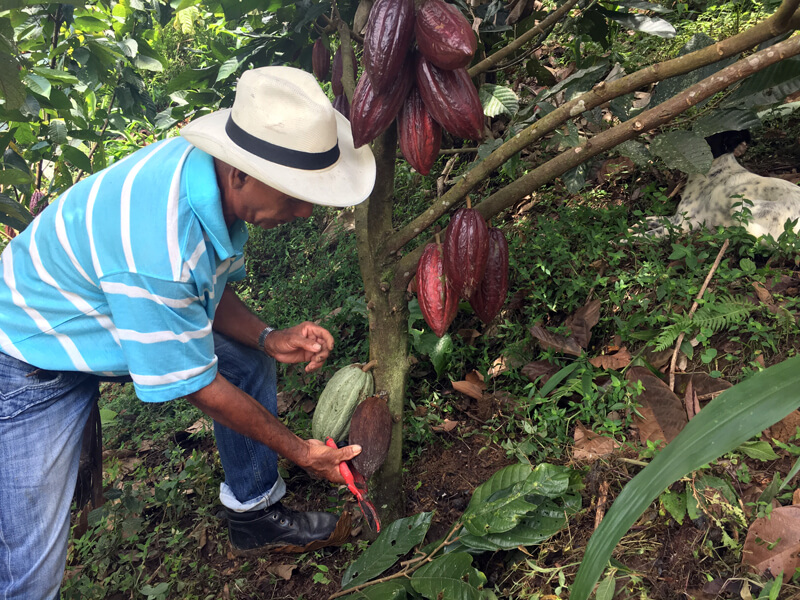
Cacao farmer Gildardo Ramirez removes a withering pod from one of his trees. He suspects the pod is infected with black pod rot.
CREDIT: LINDZI WESSEL
For Ramirez, who works with Colombia’s newly energized tourism industry to teach visitors about growing cacao, it’s a heavy workload to keep such diseases at bay. At least three pathogens frequent his farm, and each requires dedicated management. When it comes to black pod rot and the similar frosty pod — a fungus whose spores turn a pod’s surface velvety white — removing infected pods early can help prevent the spread of disease. Pods infected by another fungus, called mal de machete, stay on the tree, but require treatment with a blue fungicidal paste. Even with his diligent attention, Ramirez guesses that these diseases destroy a quarter of his annual crop.
Worldwide, 30 percent or more of cacao crops is lost to diseases each year, a persistent threat for the world’s $100-billion chocolate industry and a source of insecurity for the 40 million to 50 million people whose livelihoods depend on cacao. As Ramirez has found, any effort to boost cacao production means confronting the pathogens that so often afflict it. But much remains unknown about the diseases that target cacao. At least in Colombia, work to breed more resistant varietals or to study how cacao plants in the wild fend off pathogens has been limited. Now, as Colombia embraces a newfound stability after years of civil war, cacao science is getting a much-needed reboot.

Inside a healthy cacao pod (left) bright, white pulp surrounds the beans used to produce chocolate. Pods infected with black pod rot (suspected in middle pod) or frosty pod rot (suspected with pod on right) look less appealing and must be actively culled to keep the diseases from spreading.
CREDIT: LINDZI WESSEL
Native to Colombia and its neighbors, cacao (scientific name Theobroma cacao) has long played a role in the country’s history and culture. Unlike most other countries that grow cacao, Colombia’s production has mostly been aimed at meeting demands within its own borders — not so much for chocolate bars, but for traditional drinking chocolate. But as worldwide demand for chocolate grows, some see an opportunity to help Colombia’s farmers by increasing cacao exports. Over the last decade, Colombia’s farmers have gradually upped their cacao production. In 2016, it reached a longtime high of almost 57,000 metric tons. But that’s still short of 1991 levels (58,000 metric tons), the peak of Colombian cacao production. An overall decline followed, in parallel with growing civil unrest and other challenges.
Decades of internal conflict, fueled in part by the illicit cocaine industry, wreaked havoc on the nation. But recent changes, including a peace treaty signed with the rebel group FARC in 2016, have brought a chance to rebuild. The government and its allies are eager to eradicate the many farms that still grow coca, the source of cocaine, once and for all. Since cacao and coca thrive in similar conditions, cacao has been promoted as one ideal replacement crop. Programs such as Cacao for Peace, which is backed by the US Agency for International Development, aim to help farmers make the shift. By focusing on making cacao farming more efficient, scientists may also be able to help.
>k_subscribe_ad<>/k_subscribe_ad<For scientists, the newfound peace offers opportunity for discovery, with regions long too dangerous to explore opening again to study. Now, researchers from both inside the country and abroad are ramping up sampling of cacao and its diseases from farms and wilderness areas. With visits to remote, largely unstudied areas scientists hope to find untapped strains of cacao that may hold the keys to protect chocolate farms from some of their most damaging enemies.
Cacao’s killers
Although now grown around the world as a cash crop, cacao traces its origins to the Northern Amazon, including regions within present-day Colombia. Scientists studying cacao’s evolution say that 13 million years ago, the genus Theobroma split from its sister genus, a group of flowering plants called Herrania that today consists of about 20 species with pods and seeds similar to cacao’s. About 10 million years ago, Theobromagave rise to cacao, a mid-sized tree with small, pinkish flowers and long tapered leaves that change from red to green as they mature. Since then, cacao and its enemies — funguses, viruses, insects and others — have evolved together, developing molecular weapons and defenses in a continuing arms race.
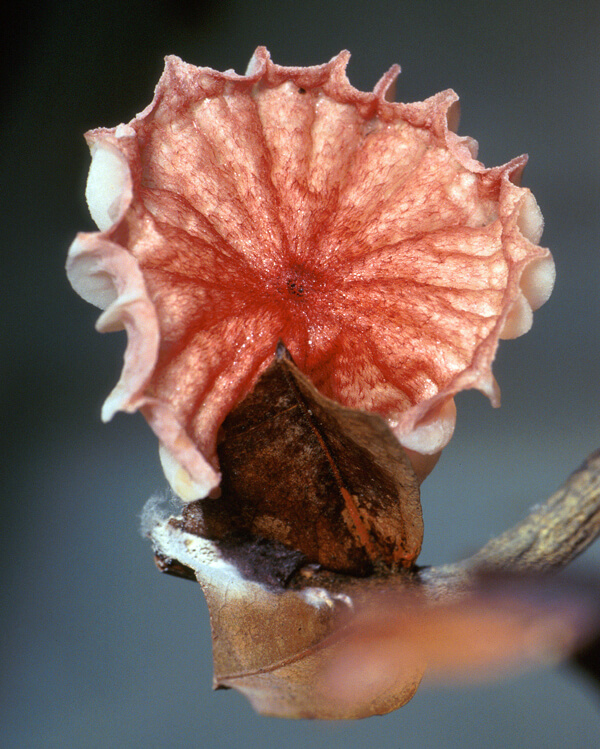
A fungus, witches’ broom forms a rosy, fan-shaped mushroom. The spores released from the mushroom aren’t so pretty: They can infect and devastate cacao trees. Witches’ broom is blamed for ravaging Brazil’s cacao exports 30 years ago, and played a role in historic losses in Ecuador early last century.
CREDIT: SCOTT BAUER/ARS/USDA
No crops are safe from disease, but cacao poses particular challenges for those who would try to protect it. Being a tree, cacao has a long life cycle that makes breeding and research more challenging. Unlike wheat and rice, which are sown anew each season, cacao trees are perennials that may be harvested for 40 to 50 years, live even longer and sometimes don’t produce their first pods for five years. Cacao’s microbial attackers, on the other hand, are much more nimble — common fungal and fungus-like pathogens of cacao can produce spores in a matter of days. In general, tropical crops also see losses almost double those of crops in temperate zones, due to pests, diseases, soil issues and resource limitations. Relatively little research money is invested in disease prevention for tropical tree crops. And most cacao that’s grown today is genetically similar, having been propagated from a narrow selection of clones.
These challenges fall hard on the shoulders of the subsistence farmers around the globe who still grow most of the world’s cacao but have limited resources and training to deal with diseases. The fallout is seen in the low production from most farms. While cacao plants can produce more than eight metric tons per hectare under ideal conditions, growers more commonly see yields that are only a twentieth of that.
Boosting the world’s cacao supply has required expanding the space where cacao is planted, rather than increasing output on existing land. It’s not a new pattern in cacao’s history, which has been marked by boom-and-bust cycles and shifting production centers since the earliest efforts to cultivate the plant on a wide scale. First domesticated for its sweet, soft pulp at least 3,000 years ago, the cacao plant spread to many parts of Central America and Mexico, where ancient civilizations used its beans as money and to brew a bitter ceremonial drink. When Europeans adopted the drink, they started to grow cacao on a larger scale, moving the crop to various colonies. But diseases found cacao no matter where it went.
These attackers have punctuated cacao’s history in Latin America with periodic disasters. A fungus called witches’ broom decimated Brazil’s chocolate empire in the late 1980s and early ’90s. Once the largest producer of the world’s cacao crop, Brazil became a cacao importer over the course of just a few years. Between 1917 and 1925, overlapping outbreaks of witches’ broom and frosty pod rot cut Ecuador’s cacao exports in half. In the 1970s, frosty pod rot slashed Costa Rica’s industry. By 1983, exports of dry cacao beans had declined by 96 percent. Four decades later, Costa Rica’s production has yet to bounce back.
Far from cacao’s native diseases and home to inexpensive labor, countries such as Ivory Coast, Ghana and Indonesia are now the focus of the world’s chocolate production, dominating Central and South American nations. Despite its Amazonian origins, 70 percent of the today’s chocolate crop is grown in Africa. Even the largest producer of cacao in South America, Brazil, grows only about 6 percent of the world’s supply. Colombia weighs in at just over 1 percent.
Cacao grows in a narrow band straddling the equator. While cacao originated in the Northern Amazon, 70 percent of today’s cacao crop is produced in Western Africa.
The chocolate industry worldwide fears that cacao’s enemies, fungal and otherwise, might jump continents or find new modes of attack. Previously unknown pathogens also could assail the crop. Frosty pod, for example, only began targeting cacao in the 1800s, likely hopping to the plant from one of cacao’s close relatives. The fungus, believed to have originated in Colombia, can produce billions of spores easily spread by wind or rain. In extreme cases, frosty pod rot can knock out a plantation’s entire harvest, so farmers must scramble to dispose of infected pods before spores spread.
And frosty pod is just one example. In the 1960s cacao plants in Papua New Guinea began to shrivel from vascular streak dieback, and in the 1970s a fungus-like disease called Phytophthora megakarya was found to have jumped from native African trees to transplanted cacao.
“It doesn’t matter how long I do this,” says Siela Maximova, a Penn State plant scientist who has traveled the world studying cacao. “Every time I go to a new plantation, I find a new disease.”
The hunt for resistance
Cacao isn’t totally defenseless against its attackers — over eons it has built up some weapons. The cacao genome was sequenced in 2010, but many of the details of cacao’s defense systems still remain unclear, as do some intricacies of exactly how diseases infiltrate and harm the plant.
Most plants protect themselves with two waves of defense. The first detects the presence of a threat. But microbial diseases that coevolved with plants are prepared for that. And they’ve designed their own tools to outwit the plant’s defenses. One tactic is blocking programmed cell death, which plants use to stop the spread of infection by killing tainted cells. Pathogens secrete immunity-suppressing proteins, called effectors, into the plant’s cells. Plants, in turn, can switch on a second-wave immune response that’s triggered by these effectors.
In a study published last March, scientists used the gene editing tool CRISPR to manipulate the immune systems of detached cacao leaves, upping resistance to a strain of Phytophthora by knocking out a plant gene that regulates cacao’s defense response. The gene ramps down surveillance when threats are low, saving the plant energy in the long term, but leaving it, at times, open to attack. Manipulating the plant’s immune responses in this way, the scientists hope, may open the door to more use of high-producing, high-quality cacao varieties that are currently difficult to grow because of their disease susceptibility.
Other scientists are looking to the wild as a source of more disease-resistant cacao that could be used in breeding programs. The first effort to seek new resistance from wild cacao plants came in the 1930s after witches’ broom made its way to the Caribbean island of Trinidad. The fungus dots cacao trees with delicate whorls that resemble tiny pink umbrellas and suck the life from their hosts, leaving once healthy branches twisted into gnarled brambles. Scientist Frederick J. Pound led an expedition to find new strains of cacao in the Amazon Basin, carefully collecting pods from trees with no symptoms of the disease.
Much of today’s cultivated cacao is descended from this collection. But as pathogens have evolved around cacao, even the most resistant of Pound’s strains have gradually begun to lose their immunity. More recently, South American cacao producers have been on the hunt again.
But Colombia is behind. Marauding guerrilla and paramilitary groups long made field research risky in much of the nation’s wilderness and countryside. So Colombia — one of the most biodiverse countries in the world — has been largely unmonitored by biologists over the past half-century. “Colombia,” says plant pathologist Silvia Restrepo of Bogotá’s University of the Andes, “is like a blind spot in the diversity landscape of the world.”
Valuable cacao plants may be thriving, undiscovered, somewhere within the country’s borders. As Colombia has slowly made strides toward peace, scientists there have started building up their collections, coordinating with various agricultural agencies to stockpile samples of cacao from farms. When researchers find diseases, they’re collecting those too — storing them for testing that will help them understand how the pathogens attack and whether new cacao varieties can deal with the wide range of diseases they might encounter in the field. But it’s wild cacao that scientists are most excited about collecting. And it wasn’t until recently that researchers finally got access the places those plants grow.
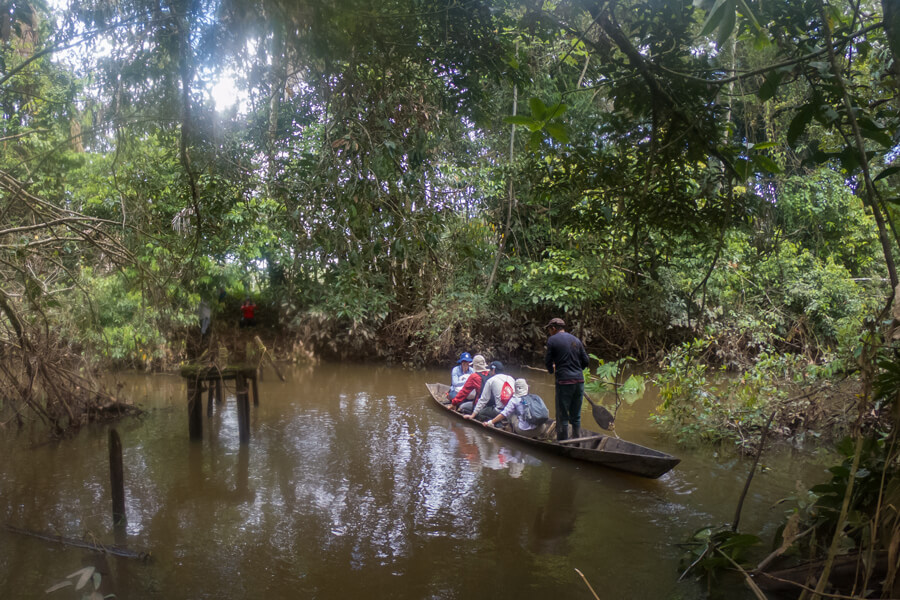
A farmer takes researchers to visit a cacao plot located near Colombia’s Mecaya River. A broken bridge means boats are required to cross this creek.
CREDIT: MONICA PARAMO, AGROSAVIA
Colombian cacao researchers have jumped at the opportunity. A group of scientists from the national agricultural research agency Agrosavia and Colombian universities teamed up under a project called Expedición Cacao Colombia BIO to collect samples of cacao from remote regions. CacaoBIO’s leader, Carlos Eduardo González-Orozco, says that there’s a sense of urgency to the work. Even as they began planning expeditions, they heard of new dangers near their target sites. The guerilla group FARC had once restricted logging in the areas, but once the group loosened its hold, clear cutting for wood and for planting crops, like coca, took off. For Colombian researchers who had waited their whole lives to study the region’s natural bounty, there was no time to lose.
“We need to collect those species before they are gone,” says González-Orozco, a biogeographer with Agrosavia. “They are like treasures.”
Into the jungle
As part of cacao’s center of origin (a title shared with neighbors in the Amazon Basin), Colombia is likely to be a hot spot of genetic diversity for wild forms of cacao and its close relatives.
For all crops, “the first thing you want to know is where is the center of genetic diversity,” says plant pathologist Bryan Bailey, noting that a plant species usually develops the most genetic diversity in a region where it’s been growing the longest. Harnessing that diversity through breeding programs can add new tools to the crop’s ability to combat disease — whether ancient or emerging.
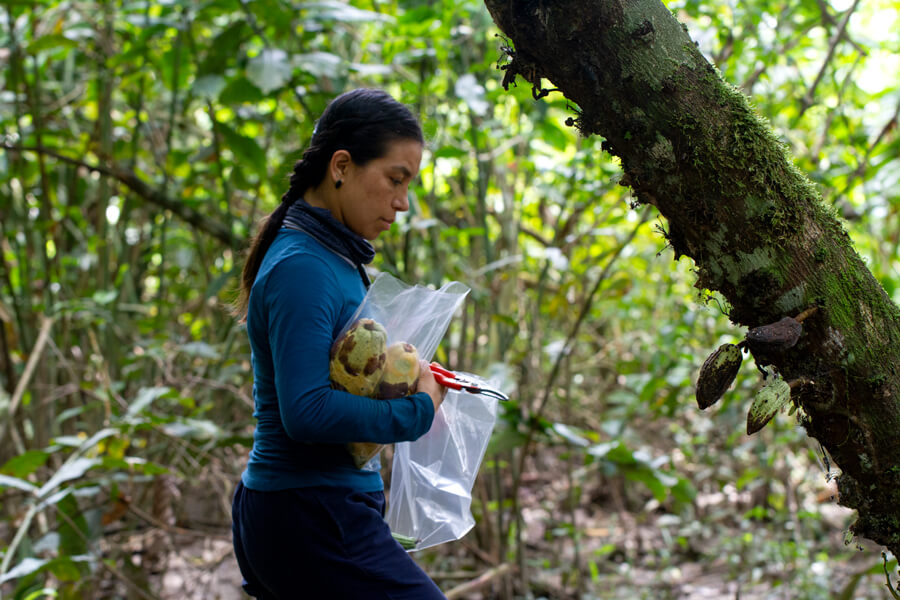
University of the Andes microbiologist Natalia Bolaños collects cultivated cacao pods just minutes downriver from the small town of La Tagua, Colombia. As part of an expedition to study cacao and its pests, Bolaños bags pods infested with the mirid insect.
CREDIT: MONICA PARAMO, AGROSAVIA
“It would be terrible,” says Bailey, who studies cacao and its pathogens at the United States Department of Agriculture in Maryland, to fight a disease for decades with no success “when you have the five trees sitting right there that would have given you control.”
With the help of tropical botanist James Richardson of the University of Rosario in Bogotá, the CacaoBIO team selected sites for two sampling expeditions within the heart of cacao’s center of origin — one on each side of the Andes. A geological event like a mountain-range uplifting should speed species diversification, says Richardson, and it’s likely the wild cacao would have differing characteristics on its western and eastern flanks. In July the group set out for an area east of the mountains, straddling the states of Caquetá and Putumayo. Soon they will explore the humid and rainy state of Chocó to the west.
The search remains challenging, given Colombia’s nascent peace and untamed wilderness. Some locations are reachable only by hours of boat travel. And while scouting out collection sites earlier this year, researchers found themselves wading through floodlands and meeting suspicious locals who pushed them to leave. At one point, the team encountered an eight-meter-long boa strangling a wild pig. But González-Orozco feels the challenges were worth it. (González-Orozco is no stranger to challenging conditions — in the 1990s, he was kidnapped twice while doing field work.) Near the remote village of Puerto Camelia, the team found people harvesting wild cacao. There were signs of witches’ broom, but to the naked eye, these plants were surprisingly free of other disease. The scientists can’t say for sure without further testing, but González-Orozco is hopeful that the plants might harbor some enhanced resistance. Nearby the team found cacao trees that were thriving despite spending months half submerged on flooded riverbanks, suggesting the trees may be especially resistant to flooding.
The researchers also collected a number of plants closely related to cacao that might prove useful in studying disease resistance and other valuable traits. “It was unbelievable,” says González-Orozco. “We found so many different species.”
From rotten potatoes to rotten chocolate
Standing in Restrepo’s lab at the University of the Andes, surrounded by tubs holding leaves and potato slices in various stages of decay, biologist Julie Ramirez holds a culture dish up to the light streaming through the window.
“I believe this one is palmivora,” she says, examining the fuzz of a black pod rot strain that has spread out from the center of the dish in an almost star-like pattern. The pattern of growth contrasts with the uniform spread of palmivora’s better-studied cousin, Phytophthora infestans, the infamous perpetrator of the Irish Potato Famine.
Restrepo’s team is trying to understand how diseases like P. infestans develop resistance to fungicides over time and how the diseases attack their hosts. One project looks at how gene expression and the production of metabolites change as the disease progresses through two phases of assault. Understanding how Phytophthora transitions from its first phase (in which it invades and nests within its host but causes little apparent damage) to its necrotizing phase (when the pathogen begins killing host cells to keep thriving) could someday help develop ways to thwart its attack, Restrepo hopes.
Recently the lab has begun expanding its collections to include strains of Phytophthora that attack cacao, with samples coming in from Colombia’s national organization of cacao farmers. Ramirez, a graduate student who, like many of her colleagues, grew up in a household where drinking chocolate was a daily staple, is heading the new project.
Researchers think palmivora is the main strain of Phytophthora attacking cacao in Colombia, but no one has ever done the work to make sure, Ramirez says. Genetic analyses will identify the specific fungal strains. That work will map the breadth of Phytophthora strains facing Colombian farmers, allowing agriculture officials to be better prepared for outbreaks and enabling more precise disease-management training for farmers.
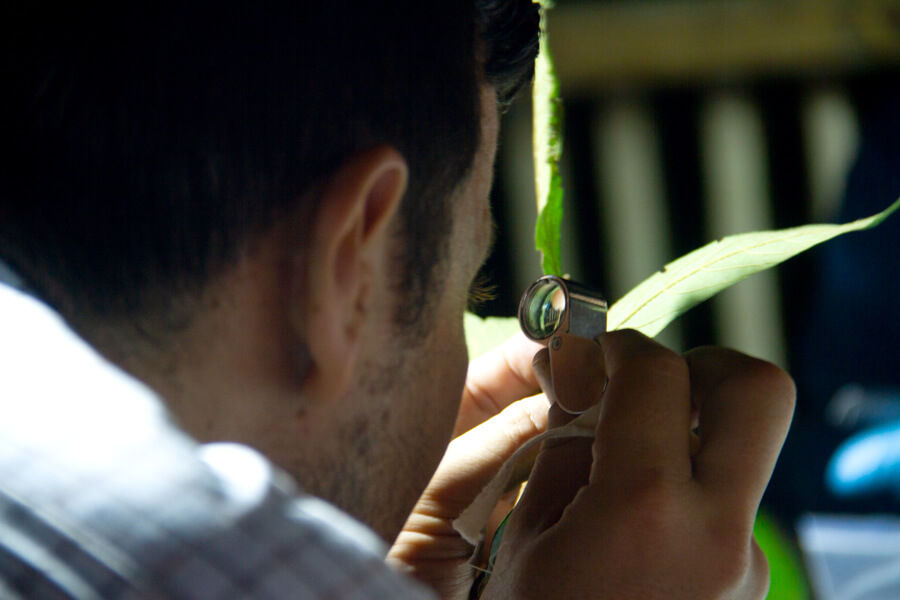
Biogeographer Carlos Eduardo González-Orozco examines the underside of a leaf from a plant found on an expedition near Colombia’s Caguán River. He’s looking for signs that it may be related to cacao, part of the Theobroma genus. Wild relatives of cacao might provide new insight into disease resistance.
CREDIT: MONICA PARAMO, AGROSAVIA
Back from the first expedition of CacaoBIO, González-Orozco is hopeful that someday chocolate can become an important export for Colombia, but he knows there is a long process ahead. Even the job of characterizing and cataloging the samples that come out of his expedition is predicted to take about five years.
And there are obstacles other than disease. For one, farms set up to grow illicit crops tend to be away from major transportation routes — an ideal scenario for producing cocaine, but a huge disadvantage for cacao farmers trying to ship their product for legal sale. Another issue: Some Colombian soils are naturally high in the toxic metal cadmium, and new European restrictions on the element in cacao could pose a trade barrier.
Education is another challenge. No matter how good the genetics of a crop, proper planning and management will always be part of successful yields, says Roxana Yockteng, a plant geneticist with Agrosavia.
In the long term, though, the scientists hope their work can someday provide farmers such as Gildardo Ramirez with high-quality, disease-resistant cacao varietals and improved tools to combat diseases that will help reduce losses. There will never be a crop that doesn’t require regular monitoring, and there will always be new diseases to tackle. But scientists hope to provide a crop that makes a farmer’s efforts a bit less risky.
“It's a very big investment for small producers to have a farm,” says Yockteng. “They have to have very good management to have good production. If not, they can lose everything.”




